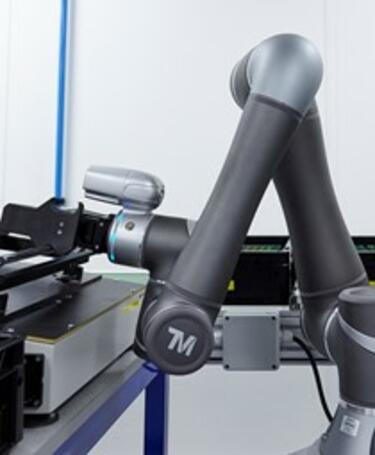
How robots are changing quality assurance in manufacturing
Progress indicator

Gaurav Bijlani, PCQI, Senior Production Test Engineer at Hanover Displays, explains how the use of a collaborative robot has helped to increase and improve output at his organisation.
Since robots have become commercially accessible, many companies are embracing automation. Robotic process automation and quality-assurance-led activities have resulted in process improvements. My experience at Hanover Displays has shown me how these two fields have converged and improved first-time pass rates, on-time delivery, and created a culture of continuous improvement.
As a result of the increased demand for high volume Printed Circuit Board Assembly (PCBAs), Sean Winter, Operations Manager at Hanover Displays, explored available and appropriate robots for testing the power supplies. After a preliminary trial at Absolute Robotics – which is a part of the Absolute Automation Group, we agreed on the installation of our first COBOT, a collaborative robot, at the Hanover Displays site in Lewes, East Sussex.
COBOT was installed and commissioned in September 2018 to perform repetitive tests and keep up with the demands of testing the power supplies. It was a huge success. The COBOT has since:
- tested 156,000 PCBAs;
- run for 1,400 hours unmanned at night-time;
- freed up 39 weeks per annum for our skilled operator to perform value-added operations;
The return on investment is expected to be 24 months.After its implementation, the test data, which was not previously available from manual testing, was utilised by the quality assurance and process improvement teams to improve the first-time pass from 94 per cent to 99.5 per cent. They utilised 8D techniques to establish a root cause for the top five errors and eliminated them.
Recently, the company decided to install an automated cell with two COBOTs working in tandem. This dual cell is being commissioned and will be ready later this year. It will depanelise the PCBAs, affix a serial number label, test the boards and segregate the pass and fail boards. This will free up 2,700 manhours for other value-added tasks in our manufacturing facility.
Every time we design new products now, we consider the volumes and decide whether it should be routed through an automated cell. A new approach to design involves consideration and agreement between design engineering, process engineering, quality assurance, operations and production support.
We have improved our output because of the higher first-time pass rates by running the COBOT unmanned at nights, redesigning our boards to eliminate additional robot movements and thereby improving delivery to our customers. Our continued failure analysis and process improvement initiatives have created a continuous improvement culture allowing different departments to work alongside the quality assurance team.
The introduction of an automated cell, COBOTs, and improving process flow at Hanover Displays has resulted in better design requirements, improved interdepartmental communication, increased interdepartmental learning opportunities for CPD plans, improved process flow, and a culture of continuous improvements.
This proves how robots and quality assurance can work together and influence a change to create a modern manufacturing facility.
Quality World

Get the latest news, interviews and features on quality in our industry leading magazine.